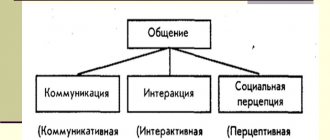During communication, people give each other delight, joy, pleasure, and sometimes disappointment and insult. In most cases, such emotions are mutual: they say that the interlocutors got along, established contact, and came to a common opinion. The latest characteristics indicate the emergence of a special feeling that unites people. Accordingly, Rapport in psychology is the emergence of a comfortable environment for two interlocutors, a feeling of mutual trust, understanding and emotional connection
.
Let's consider this definition in detail further...
Rapport in Psychology - What is it?
To be successful in life, the following four things are necessary.
First, to be in harmony with yourself and the world, that is, to recognize what exists without necessarily trying to change it (RAPPORT). Secondly, know what you want, have a clear idea of the intended result in any situation (RESULT). Third, be mindful and keep your senses open in order to notice that you are moving towards a result (SENSITIVITY). Fourth, have enough flexibility to persist in changing your actions until you get what you want (FLEXIBILITY). Sergey Kovalev. Eastern version of neuroprogramming, or textbooks on the ability to live.
- 1. Basic concept and definition of rapport
- 2.Examples of rapport
- 3.How to create rapport
- 4.Methods of establishing trusting relationships
- 5. Practical recommendations
- Why do you dream about a person you don’t even communicate with?
- Why do you dream about an ex-girlfriend with whom you no longer communicate?
- How to Overcome Barriers in Communication with Others
- Transferring thoughts and emotions to another person. Is it possible?
- 20 Golden Rules of Communication that will lead you to success in communication (+Bonus)
Basic concept and definition of rapport
A state of rapport arises between people during communication, when the degree of mutual understanding, sympathy, and favor rapidly increases.
The metaphor of such abiding is the result of resonance. At the initial moment of coincidence of frequencies of individual sources, the amplitude of oscillations rapidly increases.
The same process occurs in human communication. As soon as the interlocutors find common points (their number is unlimited), the effectiveness of communication increases many times over. The more intersections, the more people are attracted to each other, the more they can influence one another. This pattern can be applied consciously to influence people.
In other words, the definition of rapport is as follows: it is a physical, emotional and spiritual connection between interlocutors.
Important!
The ability to establish rapport in a sense means the ability to lead people.
Most often, a comfortable state for interlocutors is natural.
But if desired, it can be created artificially, moving from the consequence to the origins. In the first case, mutual sympathy first arises. Over time, people begin to exchange individual words and gestures. As a result, communication turns into a pleasant atmosphere, and mutual respect unconsciously arises. Consequence: pleasant and cordial communication, a high degree of trust in another person (as in yourself).
In the case of movement from effects to causes, one should adopt the person’s behavior style and put on an appropriate mask. After some time, with the help of skills and talent, it will be possible to establish a strong rapport.
Forms of communication and communication process
Notes
- ↑
Brief psychological dictionary - ↑ 12
Psychoanalytic terms and concepts. - ↑
All about hypnosis. V. V. Kondrashov. Ch. 4 — “Research on hypnosis in Russia” - ↑
Hypnosis and suggestion in the clinic of internal diseases. P. I. Bul, 1958 - ↑
Rapport - Encyclopedia of Sociology - ↑
Rapport - Rycroft C. “A Critical Dictionary of Psychoanalysis.” - ↑
“Stay your line. Techniques for effective communication." N. Nepryakhin (2007) - ↑
NLP as a psychotherapeutic method. — Encyclopedia "Around the World" - ↑
Chaper 8. Communicating to establish rapport — Patient practitioner interaction. Carol M. Davis, Helen L. Masin (English)
Examples of rapport
The close interconnection of people is observed in various spheres of life activity.
To understand the concept of rapport, consider the most common cases:
- Teacher and students
. The latter, as a rule, trust to a greater extent the mentor who has been in contact with them for a long period of time, with whom a close relationship and trusting relationship have previously been formed. - Doctor and patient
. Establishing rapport can improve the effectiveness of treatment therapy, minimize irresponsibility, speed up the recovery of health, and sometimes reduce the dose of pain medications. - Man and woman
. Reliable, constant rapport can improve and establish complex relationships, but its insufficiency can completely destroy even a very strong relationship.
Examples of rapport can be created endlessly.
If you observe people who are in close relationship, you will notice that their movements, breathing rhythm, postures, and other characteristics coincide. It is no secret that as a result of long-term cohabitation, a wife and husband become similar to each other. Some people can easily create rapport with completely random interlocutors. But there are also those who find it difficult to contact people. There is a belief that the ability to quickly find contact is an innate quality. Based on a different opinion, such a useful skill can be mastered and, if necessary, applied in life.
Speech as a means of communication
Attunement with your partner
How it works? Verbal and emotional interaction consists of the following:
- one of the participants in the contact initiates it at a deep level;
- the second responds to him intuitively , that is, he connects to the interaction;
- the first one feels the feedback and starts a dialogue;
- the second one is included in the dialogue.
That is, rapport is the return of a sent signal by the addressee. Below we will consider that the same model can have different forms of expression.
How to create rapport
To understand how the relationship is established, you need to consider its two main phases and the desired result:
- Adjustment
. Considering that the establishment of rapport occurs as a result of the synchronization of elements between the interlocutors, there is no need to wait until this happens by itself. You can influence the procedure by adjusting: take on the main role, and allow the interlocutor to remain himself, which will greatly facilitate communication. This will begin synchronization with your partner - adjustment to his qualities. Such behavior is perceived as a reciprocal step, and the partner unconsciously begins to trust the interlocutor no less than himself. - Maintaining
. After synchronization with a partner, as well as integration into one system, you need to comply with its laws: if one system element is violated, others must be changed to preserve the mechanism. For this reason, if the behavior of the leading participant in communication changes, then the partner follows the leader to maintain synchronization. Ultimately, the interlocutor will follow in the direction indicated to him, and it will be extremely convenient for him to do so. - Rapport
. At this stage it is no longer possible to figure out: who is the leader, who is the follower? The participants in the conversation interact so harmoniously that their changes occur simultaneously. For this reason, long-term working people think the same way.
Attention!
It is important to understand the mechanism of creating and maintaining rapport: this occurs as a result of a conscious increase in common interests at the emotional and physical levels of communication with a person.
Adjustment restrictions
Competent rapport - what is it? In psychology, it is important to not work like a simple machine; you cannot follow all the advice exactly. There will be a lot of assumptions with every person and they cannot be ignored. Otherwise, you will get the opposite effect, and you may be considered generally inadequate or not confident enough. There's nothing worse about building rapport when you get caught doing it.
Each person has several such individual traits that you cannot find them in anyone else. It is important to notice them and not even try to repeat them. Partial adjustment takes place. The state of rapport is quite achievable without copying any special features. Partial adjustment is much more common than complete adjustment.
At least at the initial stage of communication. And it’s better to choose it if:
- communication is just beginning, and you spend the first hour with your interlocutor;
- the interlocutor is overly emotional;
- the language of physiology is completely unique and unusual, there is no point in repeating it, so as not to be noticed in the attempt;
- rapport has already been established at a sufficient level, and there is no point in deepening it;
- This is your first time trying to establish rapport.
You need to start with the simplest things.
Copy the person incrementally, but don’t try to take everything from him at once. This won't work the first time. The adjustment should always be gradual so that the comfort level continually increases. All these rules work well in a pickup truck, even if that’s not what they were originally invented for. Rapport will become an excellent assistant for you in business. When you want to earn the favor of someone, just build a rapport with him and within a few hours you will win him over. If you want to learn even more secrets on seducing girls, subscribe to my VKontakte page.
Methods for establishing trusting relationships
Rapport in action
Let's consider the main ways of making adjustments:
- Adoption
. The main role is given to facial expression, manner of speaking, and distance between people. A sincere and open look should show interest in the interlocutor and his problems. The tone of voice is soft, appropriate for a confidential conversation. If an arm's length distance is maintained between the interlocutors, then this is the best option for friendly interaction; hand position and gestures should express a desire to help. - Poses and gestures
. Scientists have concluded: it is difficult for people to argue with those who occupy the same position. Based on this conclusion, a type of adjustment has been developed in which the direct or mirror position of the partner is copied. In this case, the behavior should be natural so that the interlocutor does not suspect anything. - Breathing
. The technique of adjusting to the partner’s breathing rhythm is quite complex and is not used in the first stages of training. - Speech and thinking
. The method is the most difficult, but shows excellent results. The established contact remains stable for a long time, and the dependence on distance is lost. It is necessary to analyze the interlocutor’s thinking and determine the latter’s style. Further actions are aimed at adapting your speech to your partner’s mindset.
Less important ones include adjustments to the interlocutor’s values, beliefs, human qualities, social role, and others. In addition to all of the above, there are different mixed models. The latter are effectively and successfully used in practice.
Physiological adjustment
This is the first stage of competently building rapport, and it is also the simplest.
All you need to do is to carefully observe what the girl is doing and simply copy it. Such an unobtrusive demonstration that you are on the same wavelength and you are comfortable with her. I advise you to start by observing other people, especially old friends.
You will notice that their silhouettes almost mirror each other. The same applies to the manner of speaking and even the vocabulary they use in a particular case. This is called reporting. Let's move on to the physiological part.
- Pose. The simplest and first adjustment you need to make. Look carefully at your interlocutor. After that, gradually begin to artificially copy it. Body tilt, head rotation, limb position, etc. People have their own pose for every emotion. When you adopt a pose, you also adopt an emotional background. It becomes much easier to understand the interlocutor.
- Gesticulation. This is a more subtle adjustment that is more difficult to implement. When someone tells you something, they almost always help with gestures. It’s worth copying them mentally, and when it’s your turn to speak, just show the same.
- Facial expressions. Even more difficult adjustment. Not all of us can even just frown. Everyone's facial plasticity is different, so adjusting to facial expressions may be an overwhelming task for you. To begin with, developing facial plasticity will be useful. Then you can easily copy the facial expressions of your interlocutor and establish rapport much faster.
- Breath. It's just on paper here. You need to look at the depth and frequency of the interlocutor’s breathing and simply line up with the rhythm. This is not as easy to do as you think. Everyone's breathing is different, and you will simply feel uncomfortable in most cases. There is a way out of this situation - you can almost imperceptibly move some part of your body in time with the breathing of your interlocutor.
- Verbal communication. But here everything is simpler. It will be enough for you to adopt some parasitic words, contrary to all your principles, and use them in conversation. You will also have to slow down or speed up the pace of speech in the same way as the interlocutor does.
Practical recommendations
To establish rapport in psychology, you need to choose the right adjustment method.
The latter depends significantly on the initial proximity of the participants, the situation and the communication tasks. The personalities involved in rapport also play a significant role. Each method has its own disadvantages and advantages. To achieve the desired result, it is sometimes necessary to use several adjustment methods or a combination of them.
It’s interesting how difficult it is for the average person (without innate communication skills) to learn to establish rapport to achieve certain goals. Please share your experience!
Mozhaeva Taisiya Nov 29, 2019
Modal adjustment
Rapport is also copying a way of perceiving the world.
It works great if you master this method of adjustment. I'll tell you more about modalities.
We all perceive the world differently. It depends on what source we are used to receiving information from. Based on this, a person may have one of the following modalities:
- auditory;
- visual;
- kinesthetic.
People receive the main flow of information through hearing, vision or sensations.
Depending on this, you must adapt to your interlocutor, regardless of what specific modality you have. It is very simple to determine it; just listen carefully to your interlocutor and draw your own conclusions. When they tell you a story, pay attention to what verbs the interlocutor uses. If he pays more attention to colors, says “saw, looked,” etc. – there’s a visual in front of you. If the emphasis is on sounds - auditory. The sensations are kinesthetic. Based on the results of a simple analysis, you yourself should begin to tell such stories. It’s not so easy to tell in a way that’s not in your modality, but after a few practices you’ll probably succeed. First, try your new knowledge on your friends. Try a variety of positions, mixes, etc. remember that there are people with a mixture of modalities, you also need to be able to adapt to such people.
Introduction to the Milton Model
Milton Erickson is a famous American psychiatrist and psychotherapist of the mid-20th century. He became the founder of a unique approach to hypnotherapy, which today is called Ericksonian hypnotherapy, and is widespread throughout the world. His model assumes that the speech and behavior of one person can influence others, putting them into a special hypnotic state called trance (see below). But before moving directly to trance, we need to talk about the unconscious mind of a person.
Unconscious Mind
The term “unconscious” itself is used in NLP to refer to processes that are not currently in consciousness. Those. the unconscious is not an object, but a process, because contains all processes that occur outside consciousness. The unconscious mind is associated with the body's basic functions and thought processes. And the conscious mind, in turn, reflects everything that is happening inside.
Even thinking itself occurs consciously in rare cases, because... The thoughts that appear in our conscious mind are the result of unconscious thinking. And we are aware of only a small part of what is in the unconscious mind. And, as a rule, this is only what has the greatest value compared to the rest.
The unconscious mind contains all of a person's thoughts, fears, concerns, dreams, expectations and hopes. All his life experience, skills and memories are there. The unconscious mind does not perceive direct communication, but indirect one: it reflects on symbols, figurative expressions, metaphors, etc., thereby expressing itself at a deeper level.
So how can a person access the unconscious mind and its resources? This is where the conversation about trance begins.
Trance
Trance is a certain state of human consciousness, the peculiarity of which is the focus of attention inward. The more a person is concentrated on his internal experiences (thoughts, sensations, etc.), the less busy he is with the outside world. And the deeper this state, the easier it is for a person to reunite with his inner world. In their everyday life, based on circumstances, people constantly switch their attention first to the internal and then to the external world, which means they sometimes enter a state of trance, then come out of it.
Based on the premises of NLP, we can name several modes of human functioning:
| 1 | Downtime – a person is focused on the inner world. |
| 2 | Uptime - a person is focused on the outside world. |
| 3 | Sleep is an extreme type of downtime, when the external world ceases to exist and only the reality of the internal remains. |
In a normal state, a person is usually somewhere between downtime and uptime. But here it is very important to know that these two states are neither good nor bad, and they can be assessed by analyzing your current activities. If you are crossing the road, swimming, holding a seminar, this is an uptime state. If you think about something, meditate, imagine something, then this is downtime. And it is undesirable to perform actions from the category of uptime in a state of downtime, for example, crossing the road in a half-asleep state, and meditating while jumping on one leg.
This leads to another conclusion that trance is a special state of downtime. And while in a trance, a person may seem completely detached from the outside world, but his personal experience at this time is extremely real for him, because a person in a trance is better aware of his unconscious processes.
Signs of trance
Trance can manifest itself through a number of physiological characteristics, the most common of which are the following:
- Muscle relaxation. A person in a state of trance practically does not move, and his movements themselves slow down and become smoother. Often such a person will be immobile for a long period of time.
- Low tone of voice. A person's voice in trance becomes lower due to the complete relaxation of the throat muscles.
- Relaxed facial muscles. Thanks to the relaxation of the facial muscles, wrinkles on the forehead and around the eyes disappear in a trance.
- Slow breathing and low pulse. Due to maximum relaxation of the body muscles, the heart rate decreases and the breathing process slows down.
- Changed eye expression. A person's gaze in a trance may become absent, because... he is immersed in his inner experiences.
- Dulling of reflexes. Normal human reflexes (blinking, swallowing) are observed much less frequently if he is in a trance. The reaction to external stimuli also decreases.
- State of tranquility. A person in trance is always in a relaxed state.
Another indicator of trance is certain physical states that are uncharacteristic for a person in a normal state:
| ✔ | Amnesia - everything that happened to a person during a trance is forgotten. |
| ✔ | Anesthesia - the sensations of discomfort and pain are dulled. |
| ✔ | Hallucination - a person can see what is not there and not see what is. |
| ✔ | Catalepsy - a person remains in the same position for a very long time without experiencing any unpleasant sensations. |
| ✔ | Regression - a person can return to his past and even adopt the behavior of a child. |
| ✔ | Curvature – spatial-temporal perception is distorted. |
Naturally, all of these states characterize a trance state, but if you are attentive to yourself, you will be able to see that quite often we are immersed in each of them in our daily lives.
Now we move directly to the Milton model.
Milton model
The Milton model is a specific set of linguistic techniques that are used to put a person into a trance or change his state in order to gain access to the resources of the unconscious mind. This is done in order to make it possible to make certain changes or resolve complex problematic situations. The Milton model was developed by the founders of NLP - John Grinder and Richard Bandler, and was based on the experiments of Milton Erickson himself.
Milton Model Standards
All language standards of the Milton model are based on the premises of the metamodel and are used to induce a state of trance and access to the unconscious:
- Deletions allow a person to learn what he wants to learn most. EXAMPLE. “In this NLP lesson you will easily learn...”
- An indefinite index of links allows a person to attach the right meaning to the right people or events. EXAMPLE. “Soon a person will come who will turn out to be an important figure in your life and will be able to teach you a lot...”
- Non-specific verbs are needed for a person to understand something exactly in the way that is most convenient for him. EXAMPLE. “You will give this your assessment...”
- Comparisons allow you to evoke the desired reactions in a person. EXAMPLE. “Every minute you relax more and more...”
- Judgments allow a person to remember specific moments in life. EXAMPLE. “It will be very good for you if you remember the brightest and most pleasant moments...”
- Distortions are needed in order for some action to become equivalent to some state. EXAMPLE. "Lean back and you'll feel better in no time..."
- Mind reading allows you to configure a person to benefit from performing any action. EXAMPLE. “The material will become much clearer to you if you just read this little chapter...”
- Nominalizations contribute to the fact that any action pushes a person into a cycle of subsequent actions. EXAMPLE. “As you study the material, you will increasingly begin to feel your awareness and ability to practice...”
- Cause-and-effect relationships allow you to configure a person to achieve a certain state through performing a specific action. EXAMPLE. “You breathe deeply, slowly inhaling and exhaling air. Gradually you relax and your thoughts come into order...”
- Assumptions set a person up to perform a specific action. EXAMPLE. “I don’t know if you will remain the same after reading this book...”
- Versatility allows you to remove conscious blockages. EXAMPLE. “The solution to this problem is already known to you, because... your subconscious knows it..."
- Modal operators of possibility increase a person's confidence in himself and his abilities. EXAMPLE. "You can do that! I'm sure you will succeed..."
- Modal operators of necessity allow you to motivate a person to action. EXAMPLE. “You just have to try it! If you want to understand the meaning, you need..."
And now we will talk about how to apply the Milton model in practice, because in order to learn how to use the acquired knowledge, we must master a certain structure of actions. We will look at it below.
Application of the Milton Model
Application of the Milton model involves the following three phases:
- Following a person's experience and putting him in a trance state
- Eliminating the Conscious Mind
- Accessing the Resources of the Unconscious Mind
Let's talk about them separately.
1
Following a person's experience and putting him in a trance state
The simplest way to follow is to describe to a person the experience that he receives through hearing, seeing or feeling something. During communication, you need to describe some process, without focusing on details, but giving the person the opportunity to switch to his inner world, thereby transferring him into a state of trance, because the person is immersed in himself. In this case, you need to speak not loudly, calmly, so that the person does not feel discomfort. EXAMPLE: “Imagine how good it would be if we...”
2
Eliminating the Conscious Mind
This stage is based on several standards that direct a person’s attention inward:
- Phonetic ambiguity is the use of words that sound the same but have different meanings. EXAMPLE: “Rise”, “Edge”, “Sign”, etc.
- Syntactic ambiguity is the use of words that do not clarify the meaning of the context. These are mainly adjectives and participles. EXAMPLE: “Conditioned attribute” (conditioned by you or conditioning something?), “Passionate person” (fascinated by you or carried away by himself?), “Lost material” (lost by you or lost in general?).
- Ambiguity of scope - the use of sentences or phrases in which the exact subject of the conversation cannot be understood. EXAMPLE: “Elderly women and men” (who exactly is elderly?), “Execution cannot be pardoned” (what exactly should be done?), “It would be good to do this” (who would be good or good if done? Who should do it?).
- Punctuation uncertainty is the combination of individual sentences into one complex one, from which it is impossible to understand what is being said. EXAMPLE: “We think the new material has a strong effect on you because... your day is already going differently.”
- Double binds are the use of sentences that imply a choice without a choice. EXAMPLE: “You can apply new knowledge now or later, or you can not apply it at all,” etc.
As additional techniques in the Milton model in order to tune a person into a trance state, you can use any basics of the metamodel, because when used skillfully, they stimulate his attention to immersion in himself.
3
Accessing the Resources of the Unconscious Mind
The techniques of the Milton model suggest the possibility of gaining access to the unconscious without causing a person any fears or assumptions in this regard:
- Conversational postulates - the use of questions that require monosyllabic answers, but serve as a command. EXAMPLE: “Could you imagine that...?”, “Did you know that you can read minds?” and so on.
- Tag questions are special questions that are inserted at the end of the main sentence in order to motivate a person to agree with you. Using several of these questions in a row sets the person up to agree with you altogether. EXAMPLE: “It’s easy, right?”, “You can do it yourself, right?”, “It’s convenient, isn’t it?” and so on.
- Embedded questions are indirect questions that are inserted during communication, but the interlocutor reacts as if they were asked directly. EXAMPLE: “How can I find out what exactly annoys you?”, “Could you help me by explaining a little the essence of your problem?” and so on.
- Embedded orders are indirect instructions for action inserted into a conversation during communication. EXAMPLE: “It is unknown whether you will be able to apply new knowledge in practice today,” “People with similar problems are always determined,” etc.
- Quotations are used to emphasize information obtained from third-party sources, without making any guarantees. EXAMPLE: “An acquaintance told me that NLP is very effective in communication,” “My friend said that meditation helps you relax,” etc.
- Metaphors - parables, analogies, figurative expressions are one of the best ways to access the resources of the unconscious mind. EXAMPLE: “Believe me, your potential can unfold like a lotus flower,” “Just pay attention and see how the days fly by,” etc.
In addition, it should be recalled that the foundations of the Milton Model we have discussed are not exhaustive and represent only an introduction to this topic. If you have a desire to get acquainted with it in more detail, you can turn to this interesting book.
And in conclusion of the article, I would like to say that nonverbal features in people’s communication can sometimes say much more about a person than the most informative communication, and the skills of recognizing and applying them can provide a significantly better result than any other psychological approach. It is only important to practice and do it systematically, because, as far as we know, only regular training brings the desired results.
Contact through empathy
Another, less common and more complex form of establishing rapport is achieving empathy with the interlocutor. It is usually developed through many years of experience and is characteristic of high-level specialists:
- doctors who can influence the emotions of patients;
- teachers who can force themselves to listen;
- managers who wisely manage the team;
- politicians or scientists whose speeches are memorable;
- artists whose performances penetrate the soul.
Naturally, they master this method within the limits of their competence, but they often use this skill in everyday life. This skill is acquired by penetrating a person’s emotional state. The interlocutor turns out to be defenseless in front of him, so some teachers or doctors can hurt painfully and cause severe mental trauma. And politicians and artists have to convince their viewers of what is “ordered” by employers and mislead the people.
Empathy is knowledge of human problems, in response to which a person opens up and helplessly awaits their solution by a stronger, wiser, more competent subject. This level is deeper than trust. And anything can happen here.
For example, when a doctor announces a patient's diagnosis, he can encourage him, instill hope, or create humility. And sometimes it can deprive you of hope and even lead to suicide.
The same goes for teachers who have unlimited access to the hearts and minds of their students. The teacher knows that the student wants to get an excellent, good or satisfactory mark and avoids failure. Knowing these basic things makes him practically omnipotent. But if you don’t scare students with marks, the manipulation mechanism stops working.
The list of examples can be continued almost endlessly. It will also include such precedents as gypsy hypnosis, occult influence and the curse of an evil old woman. It is also used by medical scammers, intimidating their victims with fictitious consequences of fictitious diagnoses. The same technique is adopted by “black realtors” and other unscrupulous persons.
That is, a method is just a method. In itself it is neither bad nor good, the main question is how it was used.
Voice, posture, body movements
Unlike the technique of acceptance, which is based on achieving a state of rapport through the sympathy and sympathy of the interlocutor, it is possible to achieve stable contact at the physiological level. Voice, postures and body movements, that is, physiological techniques, are often used by NLP specialists to establish rapport, since these techniques, with some practice, contribute to the fairly rapid achievement of such a goal as gaining influence on a person.
However, the time of such rapport is often limited by direct contact and quickly fades away in its absence. To consolidate the result obtained, adjustments to a higher level should be applied, for example to speech style, beliefs, way of thinking, moral values and personal experience.
To confirm this, experiments were conducted, which consisted of the following: a group of subjects was divided into two parts, the participants of one of them had to agree with each other when discussing the topic, the participants of the second had to challenge the opinion of the interlocutor. Moreover, the members of the first group took completely different poses in relation to the interlocutor, while the second group took exactly the same or mirrored ones. The results of a repeated experiment were the following: it is difficult to agree with a person who takes a different pose, or to argue if the pose is copied or mirrored.
Practice
You can start with family members, copying various aspects of their postures, gestures, voices and words. Treat it as fun and watch the reaction to your actions. At work or when communicating in other social groups, start by copying one specific type of behavior; after you get comfortable in this direction, move on to another. Notice how often you naturally copy the postures, gestures, intonations, or words of your friends. Copying occurs naturally; the only thing you need is to learn to adapt to any person, after which copying becomes automatic whenever you want to strengthen rapport with someone.
Source used: NLP Center
Share this post:
Origin of the term
It is believed that the term was introduced by two scientists: Vladimir Mikhailovich Bekhterev and Friedrich Anton Mesmer.
The term was originally used in physics in the 18th century, from where it was borrowed. The word itself is of French origin and means “to return.” The first meaning of the term differed from the modern one, denoting contact between several people, which resulted in a surge of fluids, which, in turn, helped heal the body and restore strength.











